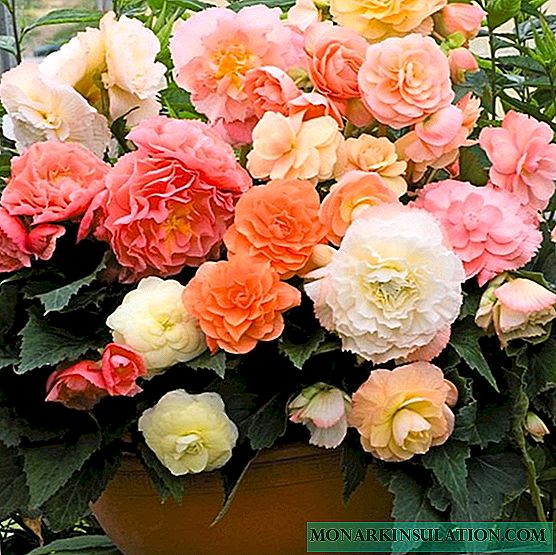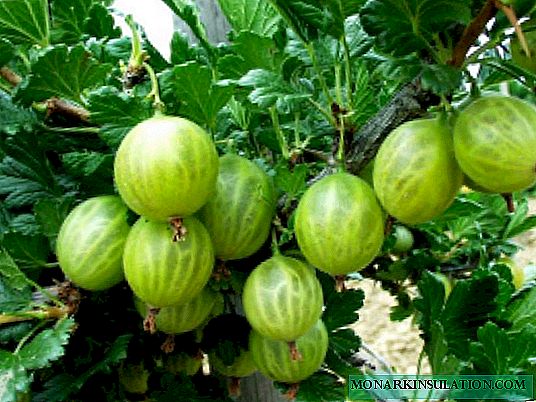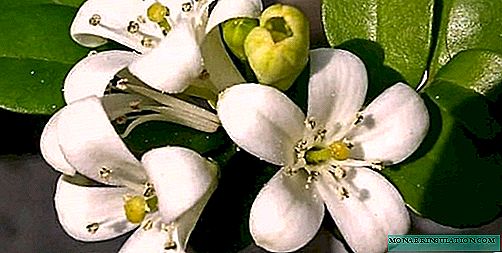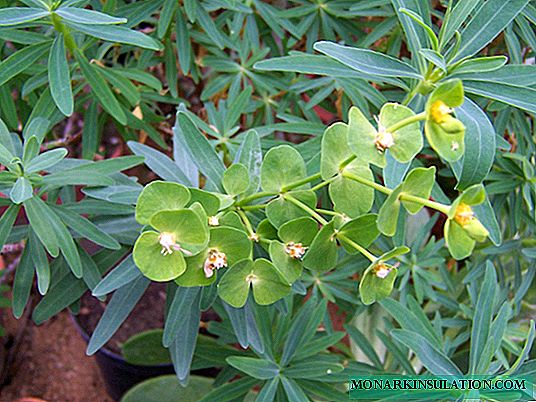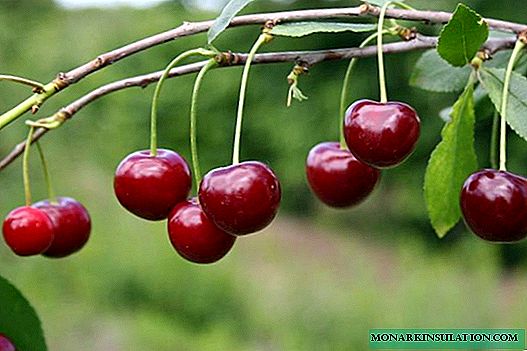
Blackcork Cherry is a small branchy tree with a semicircular and drooping crown. The variety is zoned in 1974 in the southern regions of Ukraine - Zaporizhzhya, Donetsk and Odessa regions. Cherry spread in the surrounding regions - in the Rostov region and the Krasnodar Territory of Russia. In private horticultural farms, the variety occupies the main position.
Description of cherries
A feature of the Black Cork variety is compact and low trees. Their height is not more than 3 m. They have a spreading and leafy crown with hanging branches. These properties of cherries greatly facilitate the implementation of standard work to care for it: pruning and harvesting.

Chernokorka cherries are not very tall
The thickness of the shoots is medium, they are very flexible and seem drooping. Cherry berries are juicy, have a rich dark burgundy color. Overripe fruits turn black. Berries of large sizes (up to 5 g), with juicy and sweet pulp. The sugar content of the fruit of the Black Cork is from 9 to 11% sugar. Tasting score - 4 points.
The stem is of medium length and holds berries firmly even when they are overripe. The stone is small and easily separated from the pulp.

Blackcork fruits are juicy and sweet
The variety is characterized by high productivity. With one plant, with proper care, you can collect 30-60 kg of cherries. By maturity Chernokorka refers to mid-season. Berries ripen in the last decade of June, and they try to harvest the whole crop by mid-July. Cherry has a low early maturity. Berries appear only in the fourth or fifth year of the tree's life.
In the climatic conditions of southern Ukraine, the variety tolerates drought in summer and frost in winter well.
General Description of Black Cork Cherries:
- resistant to arid climatic conditions;
- has a high yield;
- frost resistant;
- has a low rate of maturity;
- self-sterile and requires planting pollinators;
- susceptible to defeat coccomycosis.
Since Blackcork is a self-infertile variety, pollinators are necessary for the formation of the ovary. This factor should be taken into account at the stage of planting seedlings. Pollinating trees should grow nearby. These include Lyubskaya cherry, as well as cherries:
- Donchanka;
- Melitopol early;
- Aelita;
- Yaroslavna.
Blackcork young seedlings are very sensitive to sunlight and require free space.
For good flowering, you need to consider this quality, especially if you have a small garden plot. It is advisable that other trees are not planted within a radius of 4 m from the cherry. To ensure proper nutrition, an adult specimen grafted onto a long-growing stock needs 12 m2 plot.
Flowering time
By flowering time, Chernokork is medium-flowering. The buds begin to bloom from May 7 to 15. Since the variety is frost-resistant, the tree tolerates the return of frost in the spring well. The beginning of the appearance of the fruit depends on the flowering period.

The variety of cherries Chernokorka refers to medium flowering
Blooming cherry is considered a real decoration of the garden. At this time, the tree resembles a white air cloud and spreads a pleasant aroma.
During the first flowering of the tree, up to 80% of the color should be removed. This contributes to its survival.
Planting Cherries Blackcork
Planting Chernokorki seedlings is carried out in early spring. This is the optimal period, since autumn planting can lead to the death of a tree due to early frosts.
Planting pit prepared a month before planting cherries. The size of the hole depends on the volume of the root system of the seedling. It’s better to make it big: up to 1 m wide and up to 0.6 m deep. For more effective rooting, organic matter and superphosphate are added to the pit in equal volumes. The seedling root is cut to a third of the length before planting. After placing the root system in a pit, an earthen roller is poured around the landing hole. In the future, it will prevent the spreading of water during irrigation.

The size of the landing pit for cherries depends on the volume of the root system of the seedling
Some rules for landing Blackroot:
- An instance with open roots is planted only in the spring. For trees in containers, autumn is also suitable.
- When planting, the seedling is not very deep, and the root neck is placed about 5 cm above the soil level.
- In spring, long or irregular shoots are pruned on acquired trees.
- After planting, the cherries are regularly and watered a lot.
Compliance with these rules will allow you to grow a healthy tree that gives a good and high-quality crop.
Features of cultivation and subtleties of care
Black Cork Cherry Care consists of:
- forming trim;
- regular watering;
- timely top dressing.
For normal fruiting, 2-3 times a season fertilizers are applied to the trunk circles.
In spring, the tree is fed with means containing nitrogen:
- urea
- superphosphate.
In the fall, organic fertilizers are added to the site:
- humus;
- compost;
- phosphorus.
Trunk circles loosen and mulch throughout the year. For the winter they are covered with a layer of humus or foliage, and the trunk is insulated with improvised materials.
Cherry Care Activities:
- In the spring before flowering, the trees are fertilized with a solution of urea, superphosphate and potassium.
- Young plants are watered up to 4 times a month. Water consumption per tree is one bucket.
- By early fall, young seedlings stop watering.
- Means used for autumn top dressing should not contain nitrogen.
- The basal shoots, which take away nutrients from a young seedling, are regularly removed.
- In the fall, near-stem circles are mulched with the help of humus and foliage.
- Ground limestone is introduced into the ground. Its amount depends on the type of soil.
Formative pruning of the crown is carried out annually. Regular removal of young branches helps to heal the tree and give the crown a well-groomed appearance.

Regular pruning to form a crown of cherry
Video: Blackcork - early cherry, the basics of leaving
Cherry Diseases and Methods
Like all fruit trees, Black Cherry cherries are susceptible to diseases, especially fungal ones. In conditions of high humidity, the plant is damaged by coccomycosis, after which the leaves fall prematurely and the fruits die.

Coccomycosis most often damages cherry trees
Another danger is spores of monilia fungi, which provoke moniliosis. There are no varieties of cherries that are resistant to these ailments, so trees need to be processed up to 2 times per season. The composition is prepared from lime and colloidal sulfur (100 g each) dissolved in 10 l of water. Strain the substance and spray it with trees. Cherry can be processed even during fruiting.

Spores of monilia fungus provoke a cherry disease such as moniliosis
Symptoms of coccomycosis appear in early June. Signs and consequences:
- the appearance of small brown spots on the surface of the leaves;
- nucleation on the underside of a leaf of white spores of the fungus;
- leaf fall at the end of July on the affected tree.
Cherry, for which proper and timely care is carried out, is less prone to damage by fungal diseases.
The main methods of combating diseases are collecting and destroying fallen leaves, spraying trees with fungicides before and after flowering.
Reviews of the variety Blackcork
For more than forty years of cultivation of this variety, it has received special popularity among gardeners, which follows from their reviews.
Well, I don’t even need to talk about Black Cork - it’s good in flowering, and it has no equal in fruit. I don’t know how this variety of cherries is culturally called, but we call it “black-crust”, its cherries ripen late, but they are sweet, large and so dark that they are almost black. This is the most favorite variety. But what is bad is not always fruitful and the tree is big.
Elol
//sazhaemsad.ru/forum/vishnya-t414.html
For a long time, the Black Cork variety pleased me - the most breezy, small ones, but require constant protection from moniliosis.
ppima
//forum.prihoz.ru/viewtopic.php?t=1148&start=1260
Gardeners who grow on their sites a variety of black cherries, note its good yield, juicy and tasty fruits and resistance to different weather conditions. The disadvantages include the need for planting pollinator trees and regular preventive spraying from fungal diseases.


